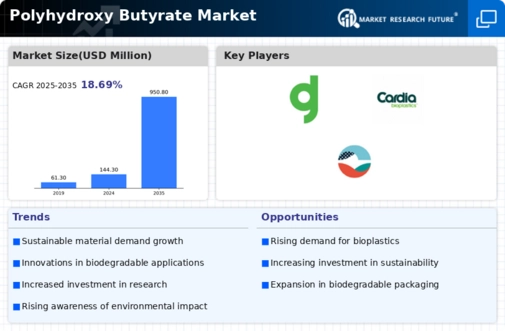Top Industry Leaders in the Polyhydroxybutyrate Market

Polyhydroxybutyrate Market
The polyhydroxy butyrate (PHB) market, where plastic transforms from villain to eco-hero, is a battleground teeming with innovation and sustainability ambitions. Players big and small vie for a slice of this burgeoning pie, utilizing diverse strategies to cater to the growing demand for environmentally friendly alternatives to traditional plastics. Let's delve into the intricacies of this market, exploring the strategies, market forces, and recent developments shaping its trajectory.
Strategies Adopted: Shaping a Greener Future with PHB:
-
Bio-Innovation Pioneers: Giants like NatureWorks and Mitsubishi Chemical Corporation invest heavily in R&D, developing new strains of bacteria and fermentation processes to optimize PHB production, improve its properties, and reduce costs. Think genetically engineered bacteria that produce PHB with enhanced strength and flexibility, or innovative fermentation technologies that utilize waste materials as feedstock. -
Cost-Conscious Champions: Regional players like Tianjin Green Bio and Zhejiang Hisun Biomaterials focus on affordability, utilizing efficient production processes and readily available feedstocks like corn and cassava starch to cater to price-sensitive segments and emerging markets. This strategy ensures their PHB solutions reach a wider audience. -
Niche Specialists: Smaller players carve out their niches by specializing in specific applications or industries. Some focus on high-performance PHB for medical devices or drug delivery systems, while others cater to the growing demand for sustainable packaging solutions in the food & beverage industry. This targeted approach allows them to excel in specialized areas.
Factors Fueling the PHB Market Growth:
-
Sustainability Spotlight: Consumer and regulatory pressure is pushing manufacturers towards eco-friendly solutions. PHB's biodegradability, compostability, and low carbon footprint resonate with environmentally conscious consumers and align with regulations promoting sustainable packaging and materials. -
Performance Prowess: PHB boasts impressive properties like excellent biocompatibility, strength, and water resistance, making it suitable for diverse applications from medical implants to food packaging. -
Technological Advancements: Advancements in fermentation technologies, genetic engineering, and material science are driving down production costs and enhancing PHB's performance, making it a more competitive alternative to traditional plastics. -
Circular Economy Aspirations: PHB's ability to be biodegraded and recycled into new products aligns with the goals of a circular economy, further enhancing its appeal in a resource-constrained world.
Key Players:
- AGRANA Beteiligungs-AG (Austria)
- Green Dot Bioplastics (USA)
- TianAn Biologic Materials Co., Ltd. (China)
- Tianjin GreenBio Materials Co., Ltd. (China)
- Cardia Bioplastics (Australia)
- FULL CYCLE BIOPLASTICS (USA)
- PolyFerm Canada (Canada)
- BASF SE (Germany)
- Kaneka Corporation (Japan)
- Biome Technologies PLC (UK)
Recent Developments:
October 2023: NatureWorks unveils a new grade of PHB with enhanced heat resistance, opening doors for its use in automotive and electronics applications.
November 2023: Mitsubishi Chemical Corporation partners with a startup to develop PHB production technologies that utilize food waste as feedstock, promoting resource efficiency and circularity.
December 2023: Tianjin Green Bio expands its production capacity and establishes a new research facility dedicated to optimizing PHB production processes.
January 2024: Zhejiang Hisun Biomaterials enters into a collaboration with a major food packaging manufacturer to develop and supply PHB-based food trays and containers.










